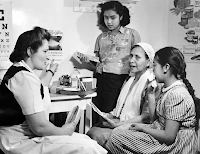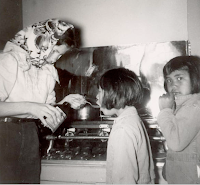No matter where you are, we're glad you're here!
 |
| AK Dept. of Health M/V Hygiene (one of the shot ships) ca. 1950's VILDA ASL-P143- |
- How have the settlement patterns of Alaska been a reflection of the natural landscape, distance, resources, and the economy?
- How have the ways Alaskans have devised education and health care systems been both a reflection of socio-cultural norms of the dominant culture as well as a response to the challenges of providing services in a vast geographic area?
 |
| Nurse on M/V Hygiene Discusses Tuberculosis ca. 1940's VILDA ASL-P143-0283 |
- To what degree is there distinctiveness in the art, literature, science, recreation, and cultural institutions of Alaska? In what way do these contribute to, or reflect, a unique Alaska identity?
ENGAGE
 |
| Giving Cod Liver Oil, Pt. Hope Classroom 1942 - VILDA ASL-P306-0595 |
Like the story of education in Alaska, the story of health care from 1867 to the present is complex.
It is the story of diseases that decimated entire communities and a high rate of accidents related to occupations and lifestyle.
It is the story of actions and reactions to the health care challenges, which taxed the efforts of governments, churches, educators, businesses, and health care providers.
It is the story of pain and heartache, as well as successes in the control and eradication of certain diseases.
It is also the story of the Western medical system sometimes in conflict with, and more currently, working in conjunction with traditional providers.
 |
| Brushing Teeth, Mission School, Yakutat ca. 1920's VILDA ASL-P56-395 |
In a larger context, the story of health care is also the story of migrants to Alaska, culture exchange and change, population and settlement, resource development, the physical landscape, and the transportation/communication infrastructure. That is, it is part of everything you have studied in this course so far.
What were the major diseases? During the Russian-America period smallpox and measles were the killers of Alaska Natives who did not have immunity to these diseases.
 |
| Hudson Stuck Memorial Hospital, Fort Yukon ca. 1950's VILDA AMRC-b85-27-1200 |
After WW I, the Spanish Influenza further decimated the Seward Peninsula and spread to other regions of Alaska. While these diseases impacted all ethnic groups in Alaska, the Native communities were hit particularly hard.
 |
| Sisters of Providence Anchorage 1956 VILDA AMRC-wwc-2268 |
While church denominations expanded their service to include the establishment of hospitals in larger communities like Anchorage, Fairbanks, and Juneau, the federal government began to take more responsibility for health care in rural Alaska.
 |
Mt. Edgecumbe Orthopedic Unit Staff Examine X-Ray ca. 1950's VILDA ASL-P143-0212 |
TB
 |
| TB Boys' Ward, U.S. Indian Health Service Hospital, Juneau 1938 VILDA AMRC-b75-175-523 |
 |
| A Dose of Medicine, Jesse Lee Home, Seward late 1940's - VILDA SCL-7-9 |
Missions added orphanages for children who had lost one or both parents. In some areas, entire communities were abandoned or relocated. Rural Alaska would never be the same.
 |
| Patients and Personnel- Mobile Health Unit, AK Native Service + AK TB Assoc. ca. late 1940's VILDA UAA-hmc-0375-partl-series1c-10-9 |
The federal government subsidizes health care for Native Alaskans, primarily through tribal health consortia or non-profit Native organizations, as part of the historic compact between the U.S. government and Native Americans.
 |
| Itinerant Nurse, Nome ca. 1940's VILDA ASL-P143-1010 |
The challenges for health care in Alaska today are both similar to other areas of the U.S. (obesity, diabetes, smoking, healthy lifestyles, aging population) and unique to Alaska (higher rates of accidents, suicide, alcoholism and providing high quality care in remote areas)
 |
| U.S. Coast Guard Helicopter and Cutter Provide Medevac Service for Injured Fisherman Dutch Harbor Dec. 2010 |
And, as more Alaskans are choosing to retire and stay in the state, health care services for seniors is a growing field.
EXAMINE
What have been the major health care challenges in Alaska during the American period?
AK Railroad Hospital, Anchorage ca. 1930's
VILDA UAA-hmc-0370-series 15b-33-1- What are the links between health care issues and the growth and development of Alaska since the 1870's?
- How have the health care issues impacted Alaska's Native population?
- What are Alaskans responding to current health care issues?
EXPLORE
- Chapter 4-21: Health and Medicine
Please also choose two of these websites to learn more about current health care systems in Alaska.
- Alaska Department of Health and Social Services
- Providence Hospital - Anchorage
- Alaska Community Health Aide Program (CHAP)
- Alaska Native Tribal Health Consortium
- Southcentral Foundation
EXTEND
So much need to know! So much nice to know! Are you picking up pieces of the puzzle? How are they fitting together?
Mental Health
The Alaska Psychiatric Institute is a state-run facility providing mental health services. The story of mental health services in Alaska is difficult and often painful. The story is about lack of services, exportation of patients to Morningside Hospital in Portland, Oregon, the creation of a land trust with which to fund services in Alaska, and lawsuits to enforce the appropriate collection and use of land trust funds.
"In Territorial Days, Alaskans could be in one of three places...Inside (in Alaska), Outside (anywhere else), or Morningside (Morningside Hospital). (Quote taken from Morningside website.)For more information on this history, here are two helpful websites:
- Morningside Hospital (website started by medical professionals to document this little known and often shocking history)
 |
| Airlift of 15 TB Patients on Reeve Aleutian Airways C-47A Cargo Plane Anchorage 1954 VILDA ASL-P143-0095 |
- What are the health care services available in your community?
- Are there particular challenges faced by those in your community related to health care? Feel free to share those.
Just a Few More Resources
These sources are not available online, but must be mentioned as being among the premier sources on disease, health care, and the historic impacts on Alaskans. All are excellent reads, so add these to your summer reading list!
These sources are not available online, but must be mentioned as being among the premier sources on disease, health care, and the historic impacts on Alaskans. All are excellent reads, so add these to your summer reading list!
By Robert Fortuine, Alaska Public Health Physician:
- Chills and Fever: Health and Disease in the Early History of Alaska
- 'Must We All Die'? Alaska's Enduring Struggle with Tuberculosis
- A Century of Adventure in Northern Health: The Public Health Service Commissioned Corps in Alaska 1879-1978
Alaska's first full-time health commissioner and legendary physician, serving 1935-late 1970's: C. Earl Albrecht - Moravian.
- Frontier Physician:The Life and Legacy of C. Earl Albrecht, by Nancy Jordan
Dr. Joseph H. Romig - Moravian, served in Bethel, Nushagak (for a fish processor), Fairbanks, Nenana and Anchorage (for AK Railroad)
- Dog Team Doctor by Eva G. Anderson
What's Next?
You've read some of the best, now for all the rest - Potpourri

